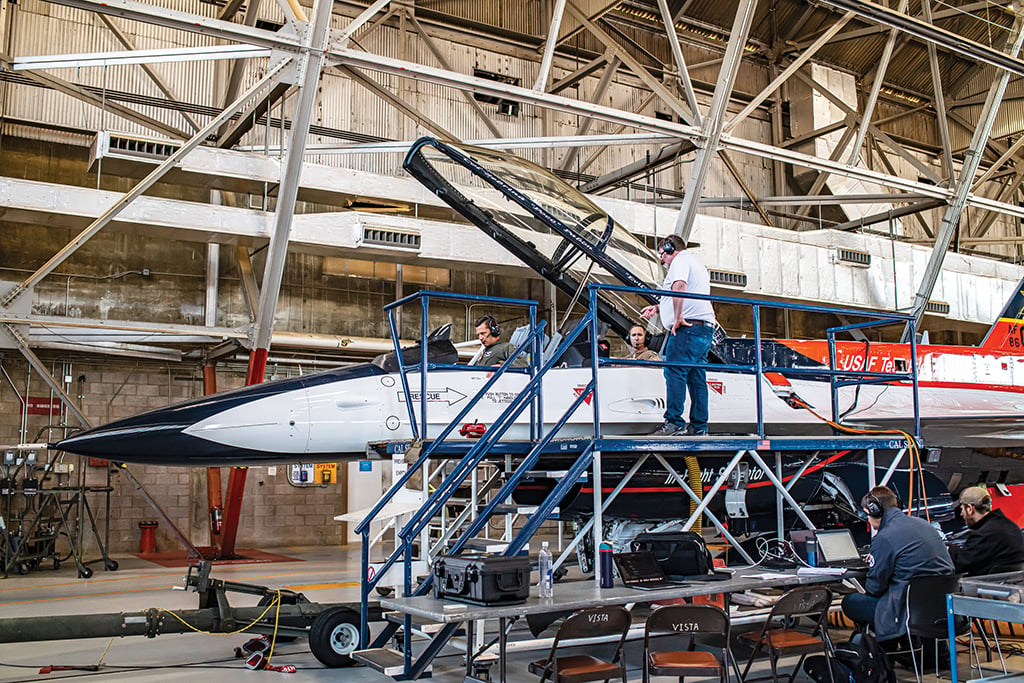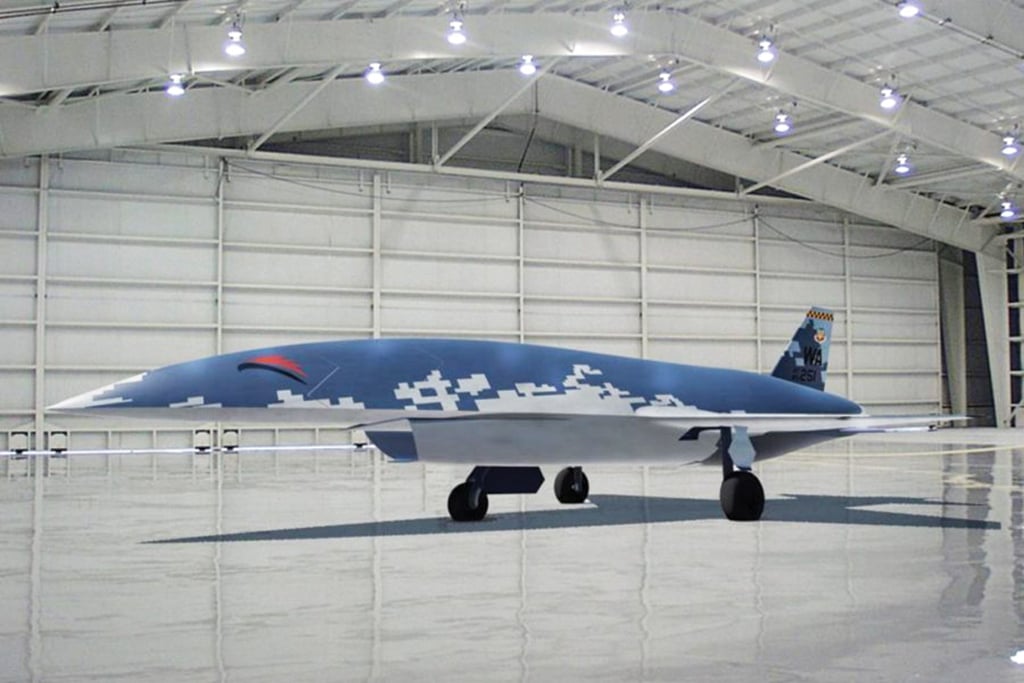
The X-62 took off from Edwards AFB on May 25 with the digital model of the Fury loaded into its unique simulation system.
An autonomous aircraft named the Fury, which does not yet physically exist, was moments from “taking off” for the first time at Edwards AFB, California, on May 26. When the moment came, the manufacturer’s lead representative had to break away from an impromptu interview.
“Fury’s flying,” said Andrew Van Timmeren, a vice president of Blue Force Technologies (BFT), moving back to a makeshift control center to focus on telemetry from a laptop display and on comments by two flight-test pilots streaming into his headset.
- The Fury’s digital model was flown on the X-62
- Flying simulator enables rapid testing of synthetic pilots and digital aircraft models
The Fury exists only as a digital engineering model loaded into a computer onboard the Air Force Test Pilot School’s (TPS) X-62 Variable In-Flight Stability Test Aircraft (VISTA).
In 2022, the Air Force Research Laboratory (AFRL) commissioned the design of the Mach 0.95 Fury from Morrisville, North Carolina-based BFT, a small company seeking to break into the military’s future fleet of autonomous aircraft with a relatively cheap and high-performance design.
Facing historically staggering odds in a quest to win a production contract for an Air Force combat jet, BFT is relying on a series of ground and flight tests onboard the X-62 flying simulator, hoping to show service officials that the Fury’s navigation and control software is mature enough to warrant the award of a follow-on development contract. With the Air Force searching for a new Collaborative Combat Aircraft (CCA), low-cost designs submitted by nontraditional suppliers may be considered.
- Download Aviation Week’s new app at AviationWeek.com/App for our team’s up-to-the-minute coverage from the Paris Air Show.
The Fury is part of a series of AFRL projects with a common theme: proving that the next generation of autonomous aircraft can be delivered at a fraction of the cost of their predecessors by leveraging digital design, low-cost manufacturing, and in some cases, modular features.
The AFRL’s campaign began in 2015 with the Low-Cost Attritable Aircraft Technology (LCAAT) project. LCAAT funded the development of the $4 million Kratos XQ-58 Valkyrie, which began flying in 2019. The LCAAT program was succeeded by the Off-Board Sensing Station (OBSS) program.
In late 2021, the AFRL selected the General Atomics Aeronautical Systems Inc. (GA-ASI) Gambit design for the OBSS contract. In a new approach to low-cost design, the Gambit is to be built with interchangeable wings, inlets, nacelles and control surfaces, allowing the operator to select different configurations depending on the mission.
The Fury shares the common, low-cost manufacturing goal of the AFRL’s XQ-58 and Gambit projects, but started out on a different track. Instead of being submitted in response to an AFRL solicitation, BFT proposed the Fury to AFRL’s AFWerx technology directorate in 2019 for a Small Business Innovation Research grant.
Unlike the armed LCAAT or surveillance-gathering OBSS aircraft, BFT proposed the Fury as a low-cost, autonomous aggressor aircraft, replacing contracted jets or scarce Air Force fighters to play the role of a target for human pilots learning how to launch simulated missile attacks. In the meantime, the service could install synthetic pilots generated by artificial intelligence (AI) in Fury aircraft playing the aggressor role.

Developing an autonomous aircraft for the adversary air (ADAIR) mission initially received broad support. The AFRL launched the Bandit program in 2021 and selected BFT to design the Fury demonstrator in March 2022, with the award of a contract worth $15 million. Meanwhile, the Air Force inserted about $67 million into long-term spending plans to build an aircraft for the ADAIR mission and met with a group of potential suppliers last October.
But the Air Force’s priorities had already begun to shift. By March, service leaders unveiled plans to spend $5.8 billion over the next five years, starting in fiscal 2024, on a new class of CCA. The funding that had been set aside to build the experimental ADAIR aircraft, meanwhile, disappeared, and Air Force officials informed industry in March that the program would be discontinued.
The decision puts the Bandit program—and BFT’s Fury—in a critical position. So far, BFT has completed an integrated propulsion test of the jet engine and nacelle and a critical design review of the Fury. But the program may need additional funding to start building the first aircraft and commence flight testing.
In the meantime, BFT engineers want to learn more about the design of the Fury—especially how the software for the guidance, navigation and flight control systems performs in flight. Although no Fury has been built, one of the Air Force’s most unique test resources can help.
That explains why a small team of BFT engineers, AFRL managers and TPS faculty gathered inside historic Hangar 1207 on South Base at Edwards AFB in late May to witness the Fury’s first digital flight. Nestled in a corner of a hangar occupied by seven other Lockheed Martin F-16s, three Northrop T-38s and a Calspan Learjet 25, the X-62’s blue, white and orange-striped livery still stands out.
Originally built as an F-16D Block 30 for Israel, the fighter was diverted off the production line in the late-1980s and sent to the AFRL. The laboratory modified the redesignated NF-16D with Block 40 avionics approved for Bahrain—omitting all classified features—and recommissioned the two-seat fighter as a flying aircraft simulator.
Ownership then passed to the Edwards AFB-based TPS, which has upgraded the aircraft to become the X-62, featuring a more powerful flying simulation system. The new configuration, dubbed the Gen2020 modernization program, also added a new feature. The X-62 now also can be commanded by a remote operator or an AI-generated synthetic pilot.
To mimic the flight characteristics of the Fury’s digital engineering model, the X-62 uses a model-following algorithm devised by Lockheed Martin’s Skunk Works, which is loaded into the onboard, Calspan-supplied VISTA Simulation System (VSS). The VSS receives throttle-and-stick commands for the Fury, then translates those inputs for the X-62’s fly-by-wire control laws.
Thus, if a pilot commands a right turn, the X-62 simulates making a right turn as if it were the digital version of the Fury—or any other aircraft that happens to be loaded into the VSS.
“So we will click ‘turn 90 deg.,’ as an example,” Van Timmeren said. “That [command] will then be sent via the ground control station through a data link up to VISTA. The guys up in the jet could have their hands up in the air, but they’re going to see the aircraft turn 90 deg. to the right.”

The X-62’s flying simulator can be controlled by an operator on the ground or an AI-generated synthetic pilot. By sending commands to the newly installed System for Autonomous Control of the Simulation (SACS), an operator on the ground or an AI agent can take charge of the aircraft, with a human safety pilot still on board for takeoff and landing and in case anything goes wrong.
The SACS received its first workout last December. Synthetic AI “pilots” created by four different organizations—EpiSci, PhysicsAI, Shield AI and the Johns Hopkins Applied Physics Laboratory—logged a total of 17 flight hours onboard the X-62, contributing research data to the AFRL’s Autonomous Air Combat Operations and DARPA’s Air Combat Evolution programs.
“One of the big benefits there is just the early involvement of the testing community and being able to integrate our architecture into this flying testbed to get the practice . . . of sending the messages up to the onboard control system, working out a lot of those kinks before there’s actual hardware yet built,” says AFRL Bandit Program Manager Alyson Turri.
The SACS offers a new approach to testing new synthetic pilots rapidly. In previous tests of the AFRL’s Skyborg autonomy agent, the Air Force needed to use elaborate airspace deconfliction procedures to operate uncrewed host aircraft, such as the XQ-58 and GA-ASI MQ-20 Avenger. By hosting such agents in a SACS onboard the X-62, the crew can take off like any other fighter, fly to a designated block of airspace in a test corridor and transfer control to the AI-generated synthetic pilot.
The same approach—minus the model-replicating VSS—is planned to be used as the Air Force ramps up experiments on future concepts of the SACS beyond the X-62. Project Venom, which was disclosed in the Air Force’s fiscal 2024 budget request, proposes to modify six F-16Ds to host AI-generated synthetic pilots, with the goal of rapidly improving the software through a high rate of testing.
“The one key technical nuance to understand is that Venom-enabled F-16s will allow for autonomy testing, just like we did with VISTA [in December],” says Matthew Niemiec, the AFRL’s experimentation lead for autonomous aircraft. “But the [Fury testing], with integration of the vehicle model to make VISTA fly like a different airplane, that is a test that is unique to the VISTA platform. It is not something that the Venom-modified F-16s will be able to represent.”
In the future, a production version of the Fury could be flown by an AI pilot. For the purposes of the X-62 tests in late May and early June, however, BFT controlled the Fury’s digital model from the ground. A data link relayed a ground controller’s commands from Vigilant Spirit—an AFRL-developed ground station—to the SACS onboard the X-62, which in turn commanded the model of the Fury loaded into the VSS.
“We thought this was kind of an interesting case in that we have a vehicle that has been digitally designed that is yet to be built, and we have the opportunity to go do some flying with that model and just see how well the design works, and out in real airspace, flying on a real airplane,” says TPS Director of Research Christopher Cotting.
Another novelty about the Fury’s first virtual flight test is the status of the X-62, which itself remains in development. As of May 26, the TPS had loaded software version 1.31 into the VSS. Several more software updates are necessary to complete VSS development with version 1.6.
“Although we’re already using it for testing, this has not finished its development cycle and its current upgrade. It won’t finish its upgrade cycle until next March,” Cotting says. “So part of the goal of VISTA [right now] is bringing in people like Blue Force with their Fury model for us to test how we’re integrating things and how well the system works. We’re learning things and finding problems as we’re working with them.”
The X-62 flew about 1.5 hr. on May 26 with the Fury’s digital model loaded into the VSS. Despite a few connection dropouts between the Vigilant Spirit ground station and the X-62, TPS and BFT officials considered it a successful first flight.
“We were able to accomplish some basic maneuvers, which included climbs and descents,” Van Timmeren said. “And we were able to characterize the performance of the jet using the X-62 as a surrogate. It was awesome.”





